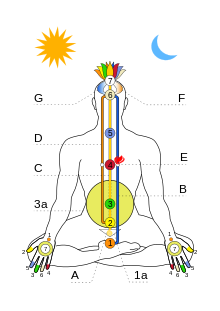
Back نادي (يوغا) Arabic Нади Bulgarian নাদী (যোগ) Bengali/Bangla Nadi Catalan Nádi (jóga) Czech Nadi (Yoga) German Nadi (yoga) Spanish نادی (یوگا) Persian Nadi (jooga) Finnish Nadi (yoga) French

Nāḍī (Sanskrit: नाड़ी, lit. 'tube, pipe, nerve, blood vessel, pulse') is a term for the channels through which, in traditional Indian medicine and spiritual theory, the energies such as prana of the physical body, the subtle body and the causal body are said to flow. Within this philosophical framework, the nadis are said to connect at special points of intensity, the chakras.[1] All nadis are said to originate from one of two centres; the heart and the kanda, the latter being an egg-shaped bulb in the pelvic area, just below the navel.[1] The three principal nadis run from the base of the spine to the head, and are the ida on the left, the sushumna in the centre, and the pingala on the right. Ultimately the goal is to unblock these nadis to bring liberation.
- ^ a b B. K. S. Iyengar (2010). Light on Pranayama. the Crossroad Publishing Company. pp. Chapter 5: Nadis and Chakras.
© MMXXIII Rich X Search. We shall prevail. All rights reserved. Rich X Search